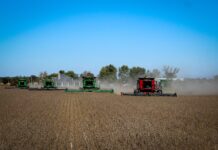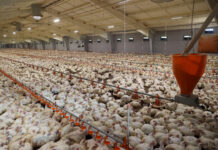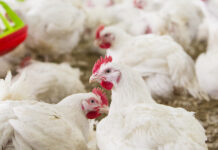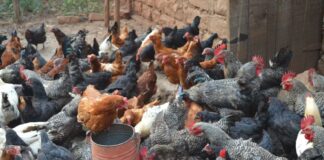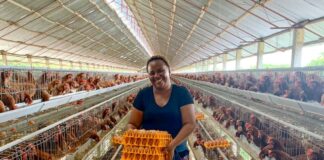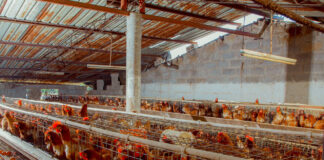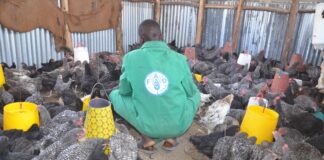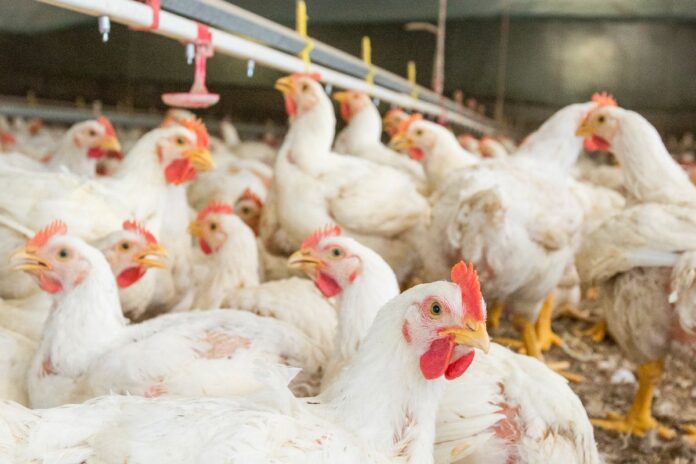
When it comes to improving performance through nutrition, meeting poultry requirements in the way they want/need is paramount to fully achieve their genetic potential. Indeed, the type of feed and how feed is presented matter to improve productive efficiency.
Meeting nutrient requirements
Current selection of meat and egg chickens has resulted in a broad, worldwide range of commercial strains of chickens for multiple production systems. And, due to continuous artificial selection, commercial lines of chickens change year after year due to genetic progress for improved efficiency, productivity, and/or resilient. Yet, these changes in performance and robustness also carry nutrient specifications to support greater performance. For example, highly productive layers requires high mineral needs to support laying persistency and prevent bone weakness (and associated health problems) at old ages. In the case of broilers, accelerated body weight gain comes at the cost of high protein consumption to attain such fast growth rate despite of improvements in feed efficiency. Thus, proper understanding of strain-specific requirements is paramount to safeguard poultry health as well as to evaluate on-site production efficiency.
In line with this, poultry requirements vary with age. During rearing, three main developmental stages are: skeletal development (during the first weeks of age; chick stage), adequate organ development (starting around 6 weeks of age; juvenile stage), and sexual development (onset with juvenile-to-adult moult). Bones elongate quickly during their first weeks of age, and this period is crucial to develop a wide, vigorous frame on which muscle will anchor. This becomes handy to achieve heavier body weights in broilers or maintain laying persistence after peak of production in layers. Then, pullets and cockerels need a steady growth rate to compensate for such fast growth rate during early rearing as organs such as heart and lungs cannot enlarge as quickly as muscle does. Consequently, maintaining a fast growth rate during this phase is risky and can lead to health problems like breathing issues and heart failure as these organs are underdeveloped for such heavy body weight. Finally, sexual development kicks in once mature body weight is reached at a good conformation (neither undernourished nor overweight). If flock uniformity is compromised, so is sexual maturation. Avoiding unnecessary stress and getting a good flock uniform is core to synchronize laying onset and sustain proper performance during lay. So, minding chicken development stage is crucial to implement feeding strategies that support poultry well-being, health, livability, and meat quality.
Lastly, previously-mentioned requirements linked with age and strain are also dependent on current performance. Certainly, nutritional requirements will drop if performance outcomes are below expected objectives and, oppositely, if flock performance exceeds objectives. Monitoring flock performance live is therefore ideal to gauge whether nutrients are over- or under-provided since both are problematic. Customizing the on-site feeding strategy to actual performance (and environmental conditions) for a given genetic strain and age are desirable to optimize production efficiency, but how can feeding strategies satisfy these needs?
Phase-feeding
Implementing a three-stage feeding program during rearing and a two-stage feeding program during lay is the first step to satisfying strain-nutrient specifications across different developmental and production stages. Phase feeding means that different diets are fed through rearing (e.g., starter, grower I, grower II, or finisher diets) and lay (layer 1 & layer 2). Although diets may look similar, they are designed especially for broilers and layers to support their specific performance objectives at given development stages.
Rearing feeding programs often have high protein content to meet birds’ growing demands while layer diets are rich in calcium for eggshell formation. Particularly in the last period of their production cycle, phase-feeding is remarkedly important to help achieve market body weight quickly in broilers or boost laying persistency in 50-weeks-old hens (when mineral content could limit egg quality or bone integrity). Another advantage of phase feeding is that feed particle size is adjusted to chickens’ age. Since newly-hatched chicks cannot feed on large feed particles, they require mash during their first weeks of age and gradually transitioning to crumble and pellets as they grow.
Although phase-feeding is useful to meet poultry needs as they grow, introducing new diets (e.g., from grower to layer diet) can be stressful and transitioning periods or intermediate diets (e.g., pre-layer diet) can lessen this stress. Another thing to keep in mind is that commercial diets and feeding programs are formulated to match bird type, developmental stage, and expected performance; nonetheless, checking out that the feeding strategy supports current performance is important to ensure productivity is not constraint, for example, in the case a flock is overperforming.
Nutritional enrichments
Supplementing barn environments with nutritional enrichments, beyond their main diet, cannot only support their nutritional requirements (such as mineral intake using pecking stones) but also promote feed digestibility and cut feed waste. As chickens lack teeth to grind feed, feed intake enters directly into the digestive system. In here, the gizzard act as a mill grinding feedstuff and its activity is improved when chickens consume grit or small stones (as they tend to do when ranging). Grit intake further promotes grinding activity by breaking feed down into finer particles before entering the stomach where it is mixed with gastric acids. In return, digestibility in the small intestine increases due to grit intake facilitating nutrient intake for the same amount of feed intake and diet.
Chickens are not particularly picky eaters but still enjoy sorting crumbles/pellets out. This redirected behaviour toward feeder content can become a problem because of feed waste, predominantly in cage systems as feed falls on the manure belt or hallway floor where birds no longer have access to it. Regardless of whether this behavioural problem roots from boredom or lack of dietary fibre, this behaviour carries an economic loss. A strategy to tackle both possible causes is providing baskets full of straw or wood shavings inside cages so chickens can engage in this pecking behaviour while reducing feed waste and allow them to meet dietary fibre intake as they please. For floor systems, straw bales (or similar options) provide opportunities to performance this feed-seeking behavior and redirect it away from feeders. Overall, planning a proper feeding enrichment can further help satisfy nutritional requirements (e.g., mineral and dietary fibre) when birds are in need of it and support foraging-like behaviours while also reducing economic loss.
Supporting feeding behaviour
Understanding poultry feeding behaviour can help accomplish higher individual daily feed intake, enhance uniformity of body weight (and other performance outcomes as well), and avoid feeding competition. Indeed, improvements in feeding strategies are pointless if chickens do not use resources appropriately. Chickens are social animals by nature, and they forage at the same time as a group preferentially after dawn and before dusk (except for broilers that do a large meal early on followed by periodical, small meals along daytime). However, if feeder space does not allow all birds to eat simultaneously, they will compete for feeder access during feeding time. In this scenario, bullies outcompete small chicks resulting in poor uniformity, reduced productivity, and welfare problems due to injurious pecking. Also, adjusting feeding time to match their natural feeding patterns can further trigger their motivation for larger feed intake. Having a large meal before dusk is important for laying hens since egg formulation occurs during nighttime, and hens must intake enough calcium at the end of daytime to prevent soft eggshells. A welfare-friendly solution to this problem is running trough belt again (with fresh feed) around 30 min before lights go off while also dimming light intensity gradually to mimic sundown. Thus, hens learn that the dark phase is coming and can compensate for feed intake if necessary.


